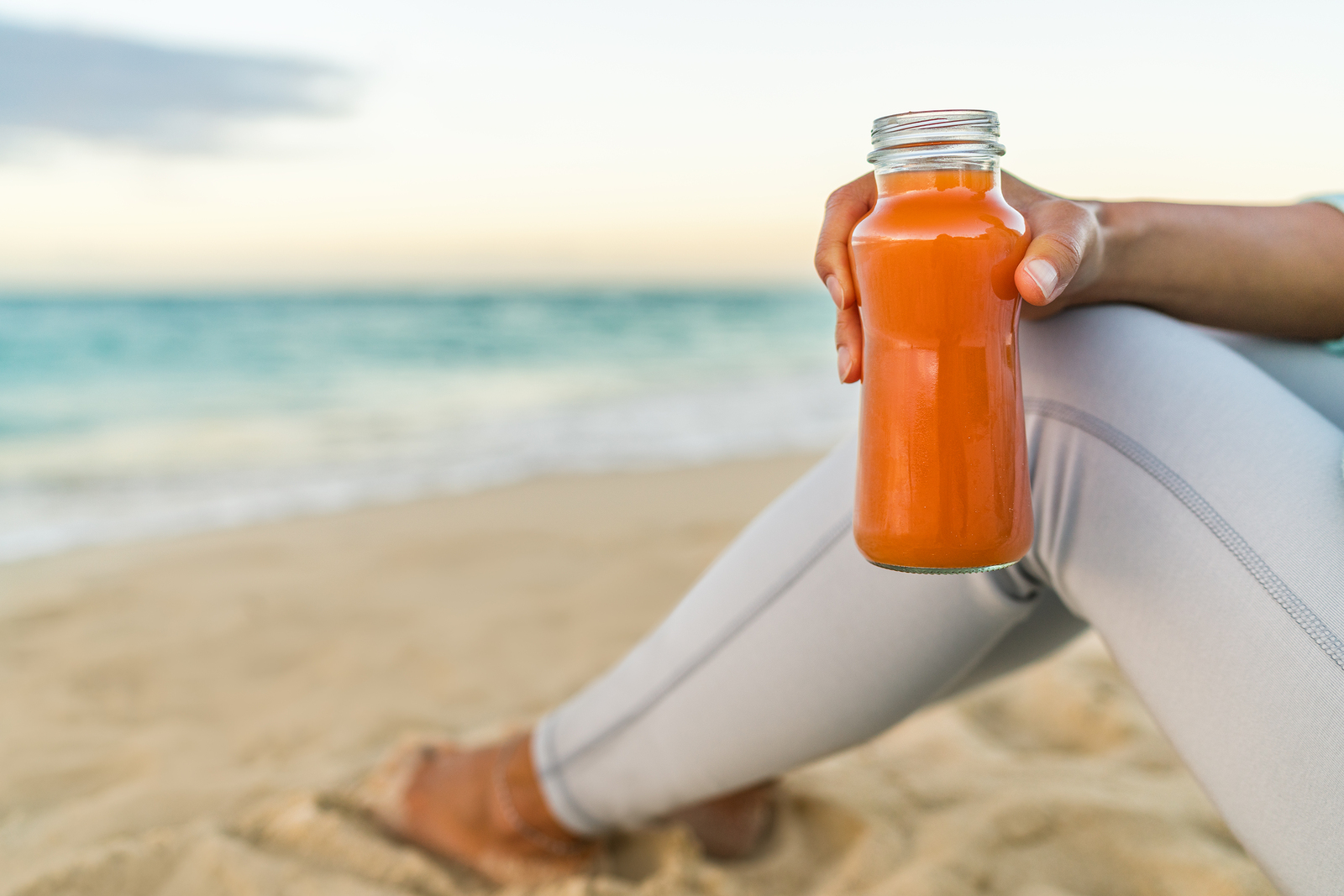Many women I talk with are confused by the conflicting voices constantly chiming in on caffeine – I would be too!
Does caffeine harm or help your body? Does coffee cause breast lumps? Hot flashes? Ulcers? Does it help liver disease, diabetes, Alzheimer’s or Parkinson’s? How much is safe? What constitutes an addiction to caffeine? It seems like every time we turn around, there’s some new report weighing in on the caffeine controversy. These reports alert people to either the relative dangers or health benefits of caffeine use, but which is it?
There are plenty of people rooting for caffeine. Drinking a cup of coffee or tea is a huge source of pleasure for many; a personal or social ritual that provides a wonderful sense of warmth and connectedness.
It seems like the more we investigate caffeine, the hazier the picture gets. The AMA and the ADA suggest that 1 – 2 cups of coffee per day is a safe amount (approximately 100–200 mg of caffeine). Your body may differ – you could be sensitive to less, or able to safely tolerate more.
I believe that caffeine tolerance varies from woman to woman and depends largely on how caffeine interacts with her individual physiology and how efficiently she detoxifies — but there’s the rub. In order for a woman to hear her body’s real signals, she’s got to remove caffeine long enough to tune in. And because it’s addictive, even this temporary caffeine withdrawal can be a real source of anxiety and discomfort for many women.
So whether you have a one-cup or one-pot-a-day habit, it may be time to look at your caffeine use. Is it time for you to go on a brief caffeine holiday? Let’s learn more and find out.
The Caffeine Culture
Caffeine has been used in various forms for thousands of years to promote wakefulness, mental clarity, and social interaction. It is a compound (xanthine alkaloid) found naturally in many plants, primarily coffee beans and leaves, tea leaves, yerba maté, guaraná berries, Yaupon holly, and the kola nut.
Ninety percent of Americans (including children) consume caffeine every day. It is everywhere. Coffee, teas, chocolate, blended smoothies, power and energy drinks — even in enhanced waters! Starbucks has revolutionized caffeine use by ensuring that wherever its customers go in the world, a consistently good cup of coffee and pleasant atmosphere await them. And Dunkin’ Donuts marketing campaign tells us that “America runs on Dunkin’” — and its high-sugar, high-fat coffee Coolattas. (A small Coolatta contains 22 grams of fat, 14 of them saturated. A large has 28 grams of saturated fat, 700 calories, and 25 teaspoons of sugar).
If you are having trouble with the idea of giving up your daily caffeine, you have good reason. Caffeine is addictive on many levels, not the least being its role in social, historical, commercial and private ritual. If you’re not sure whether or not you are addicted, take our quiz and find out.
The Caffeine Addiction Quiz
Answer yes or no to the following questions.
- Do you use caffeine to facilitate a physical activity (for example: waking up, exercising, having a bowel movement, concentrating)?
- Do you have to have caffeine in the morning? Can you substitute hot water with lemon?
- Do you crash or have caffeine/sugar cravings in the afternoon/early evening?
- Do you grow irritable, have headaches, feel disembodied if you miss your caffeine fix?
- Do you have difficulty falling asleep at night and waking feeling refreshed?
- Do you need caffeine to heighten the effects of other substances, e.g., nicotine, alcohol, sugar?
- Do you feel your social routines would suffer without caffeine use?
- Does the idea of going without caffeine seem impossible to you?
If you answered “yes” to 2 or more of these questions, it may be time to examine your attachment to caffeine. Any time a woman feels she cannot be herself without using a substance (natural or synthetic), it raises a big red flag for me.
Caffeine Tolerance
Some women, like my colleague’s 80-year-old grandmother, can drink coffee every day of their adult life with no problem. Another woman may tolerate caffeine well for some years only to find it worsens her chronic anxiety and fatigue as she approaches menopause. And yet another may find any amount of caffeine triggers more severe concerns.
In my opinion, caffeine tolerance relates largely to how well a woman is able to detoxify. We detoxify most efficiently in our sleep – the very thing caffeine works against! I believe that, for many women, habitual and/or excessive caffeine use ultimately sabotages the body’s defenses. In the decades I’ve been treating women, I’ve seen that even moderate caffeine use causes particular problems for three kinds of patients: women suffering from adrenal burn-out (a rapidly growing group); women who are insulin resistant and aren’t getting their energy from food; and slow detoxifiers (a smaller but significant group).
So the last and most relevant question for you to answer is: How do I respond to caffeine?
The Caffeine Cycle — Energy Boost, Then the Letdown
One way to begin to understand the part caffeine plays in your health picture is to look at how it affects the inner workings of your body.
Caffeine fools your fatigue factor. The molecular structure of caffeine resembles that of the neurotransmitter adenosine, but has the opposite effect on brain cells. Adenosine helps you feel drowsy by slowing down nerve cell activity within the brain’s arousal centers. This allows the brain’s blood vessels to dilate, in turn allowing more oxygen in during sleep. Adequate adenosine levels are critical for good sleep cycles. And since our brains and bodies detoxify and heal with sleep, adenosine levels have a role in our larger health picture.
Because of its similar structure, caffeine binds to adenosine receptors on nerve cells, like a key in a lock, so that the nerve cells can’t interact with real adenosine. Instead of slowing nerve cells down, caffeine speeds them up and constricts the blood vessels in the brain. This is how caffeine can impact sleep cycles, diminishing healing and detoxification efforts in the body. This explains why caffeine is often used as a headache treatment – it shuts down swelling blood vessels in the brain.
Fight or Flight
Caffeine flips the “fight or flight” switch. Caffeine increases the rate at which your neurons fire, stimulating your central and sympathetic nervous systems through the HPA (hypothalamic-pituitary-adrenal) axis. It also triggers an upswing in cortisol and the neurotransmitter dopamine, which activates the pleasure center in the brain. In this way caffeine is similar to – but less potent than – cocaine, amphetamines, and other psychoactive stimulants.
With 100–200 mg of caffeine (less than one short cup of Starbuck’s drip coffee), levels of norepinephrine, epinephrine and adrenaline increase. This is the same “fight or flight” response to a perceived threat that sends the message – think fast, act fast. You experience a surge in mental alertness and increased muscle coordination and endurance. The pupils dilate, the heart beats faster, blood vessels and breathing tubes dilate, muscles constrict, and the liver releases sugar and free fatty acids into the blood for energy. You are literally poised and ready to out race and outwit the danger — but most of the time you’re sitting at your desk or in your car.
Crash and Burn
When the rush is over and adrenaline levels drop, fatigue, irritability, inability to concentrate, headache and weariness take over, setting the stage for a big caffeine — and sugar — craving. Caffeine is a habit-forming drug, and over time it takes more and more caffeine to produce the desired effect. It also enhances the effects of other stimulants, such as nicotine. Habitual users will experience real caffeine withdrawal symptoms within hours of reducing intake. Headaches and a drop in blood pressure, nausea, fatigue, irritability, anxiety, and depression are common.
Caffeine Clearance in the Liver
The half-life for caffeine in the body is anywhere from 3.5 to 6 hours, depending on the individual. Many of you can blame that afternoon slump on your morning coffee!
Caffeine has three metabolites: paraxanthine, which increases lipolysis from the liver (free fatty acids into the blood); theobromine, which dilates blood vessels and increases urine output; and theophylline, which relaxes smooth muscles of the bronchi. These metabolites are broken down further and excreted in the urine.
Importance of Detoxifying Caffeine
Coffee and tea do contain antioxidants that help detoxify the liver and fight disease. The journal Gastroenterology reported in 2005 that more than two cups of coffee a day may actually cut the risk of serious liver damage in half for people who are obese, diabetic, alcoholic, or have too much iron in their blood — that is, those who are at higher risk for liver diseases. Whether we like to admit it or not, the reality is that coffee and tea are the main source of antioxidants for some people.
A subset of people who are slow detoxifiers may have a genetic variant of the caffeine-metabolizing enzyme CYP1A2. These people metabolize caffeine at a slower rate so it lingers longer, increasing the potential for negative effects. According to one study, carriers of the gene variant who drank two to three cups of coffee a day had a 36% higher risk of heart attack than those with the faster gene. When intake increased to four cups daily, the risk shot up to 64% greater — and even to four-fold for people under 50!
Which underscores my point that caffeine in and of itself may not be a problem if you are an efficient detoxifier. If, however, you have this genetic variant or your detoxification system is overloaded in other ways, caffeine use may tip your health over the edge. It’s also possible that the myriad other chemicals in coffee and tea (like pesticide residues) are what tips the balance.
Standard genetic testing would be extremely useful here — but until then, self-knowledge is your best bet.
Caffeine and Insulin Sensitivity
Not too long ago, large-scale studies in Japan and Canada reported that in some people, caffeine use may help ward off type 2 diabetes by decreasing insulin sensitivity. Yet for those who already have type 2 diabetes, caffeine may worsen the condition. Caffeine’s effect on insulin sensitivity also varies significantly between men and women, what condition the body is in, and whether taken when fasting or with meals. So while it remains unclear just how this is all connected, the data clearly points to caffeine as a highly active metabolic agent, and it is probable that other substances in coffee and tea are playing a role as well.
I think it is best to weigh the pros and cons in the context of your own health history.
Special Considerations for Women and Caffeine
My biggest concerns for most women with chronic caffeine use are increased anxiety, insomnia, inflammation, and adrenal burn-out. Symptoms of fatigue, PMS, sleeplessness, and breast tenderness are exacerbated by caffeine use. Caffeine distances you from your natural energy cycles, tricking your body into a constant state of alert. This ultimately makes you more tired. If you use caffeine to cope with stress, you can’t ignore the fact that your solution may be part of the problem.
Chronic caffeine use places a huge demand on your adrenals. Most of my patients who abuse caffeine do it because they are stressed-out and tired all the time. Often they combine caffeine with sugar or simple carbs, a potent duo that triggers all the alarms in the body and sets the adrenals on an energy rollercoaster. And this equation may worsen with time.
Caffeine and women’s hormones
If you are trying to conceive, even one cup of coffee a day can decrease your success rate. In addition, caffeine crosses the placenta, so if you are pregnant and drink coffee, you are sharing the risks with your baby. Even moderate use doubles the risk of delivering underweight babies and miscarriage.
Nursing mothers who drink coffee may inadvertently cause withdrawal symptoms in their infants, because caffeine is carried through breast milk. If your baby is colicky, try going without caffeine for a few weeks and see if there’s a difference! There is also some suggestion that caffeine causes breast tenderness and may increase the incidence of fibrocystic breast lumps in women of all ages. Clearly, if you are pregnant, nursing, or want to be, or if you have a history of lumpy or tender breasts, it’s best to avoid or severely limit caffeine.
Many of my patients who never had a problem with caffeine find it affects them differently as their hormones begin to shift. This is likely caused by a combination of estrogen loss and the decrease in rates of metabolism and detoxification that occur naturally with age.
During menopause, caffeine can heighten symptoms like anxiety, hot flashes, bone loss (by leaching calcium), heart palpitations, insomnia and mood swings. And because it is addictive, it can be very hard to stop caffeine use at this time when so many women already feel physically off-balance.
The bottom line is there is no way to know what power caffeine holds over you until you try eliminating it for a little while.
Breaking the Caffeine Cycle: Marcelle’s Approach
Keep in mind that I’m not suggesting you live the rest of your life without caffeine — only that you move toward a healthier relationship with it.
But be prepared — caffeine is not an easy drug to quit for some women. I see patients in my office willing to make every other single lifestyle change I suggest, yet who break down in tears when I suggest giving up caffeine to take an adrenal test. So don’t stop cold-turkey unless you want to. There are many half-measures that can ease the way, like substituting beverages with less caffeine.
Note that the caffeine content of coffee and tea can vary widely from cup to cup. A general rule of thumb for coffee is that the darker the roast, the lower the caffeine content. Espresso actually has less caffeine than drip coffee. Arabica beans are lower in caffeine than Robusta. Green and black teas are lower in caffeine than coffee. But again, you want to take a cumulative look at your daily consumption.
And while you slowly cut down on your caffeine consumption, you can build a better support system by adopting the following measures.
Recognize That Caffeine is Not Food or a Fluid Replenisher
Although coffee and tea contain antioxidants, they are in no way a good substitute for real, whole food. Drinking coffee on an empty stomach increases stomach acid, which can cause peptic ulcers, heartburn, and worsen GERD (gastroesophageal reflux disease). Complementing your coffee with a big sugary snack, or adding a lot of sugar to sweeten it, upsets insulin and cortisol levels, particularly if there is no protein or healthy fat to take the edge off. Drink a glass of water upon arising and then eat a high-protein breakfast. If you still want your cup of coffee or tea, drink it after you have eaten. If your hunger is actually thirst, drink a glass of water or herbal, decaffeinated tea before you turn to coffee or caffeinated teas.
Go to Bed Earlier
There has been research linking higher caffeine consumption with people who are “night owls” relative to “larks” (early-risers). So, weaning from caffeine may be easier if you set an earlier bedtime and strictly adhere to it. Allow yourself a full eight hours of sleep. Not only is this important for detoxifying, it may transform your energy levels in the morning, lessening your need for that first — or second or third — cup of caffeine.
Increase Your Optimal Nutrition Levels with a Multivitamin, Complete with Essential Fatty Acids, Calcium and Magnesium
If you drink caffeine, you are depleting your body of necessary nutrients (it’s a lot of work to stay in crisis mode). Caffeine increases the uptake of calcium from bones, so supplemental calcium is important. And your fatigue may be due in large part to inadequate nutrients.
Drink More Water to Help Detoxify
Caffeine is a diuretic, meaning it dehydrates. If you increase your uptake of water, you may find that you have less craving for soda, coffee or tea. Water also helps flush toxins, including caffeine, through the system. What’s more, caffeine is very acidifying. Detoxification is more efficient in an alkaline environment. Although water is neutral, it helps dilute acidifying agents.
Choose Organic Coffee and Tea to Cut the Amount of Pesticides You Ingest with Each Cup
Ask for an ingredients list with your favorite brand name caffeine-enhanced drink. Pay attention to all the extra chemicals, sweeteners and flavorings (not to mention calories). Caffeine may only be the tip of the toxic iceberg.
Consider Buying Organic Fair Trade Coffee to Promote the Ethical Treatment of Coffee Farmers Around the World (Most of Whom Live in Poverty-Stricken Regions)
Coffee farmers are not the ones getting wealthy off our consumption – the Fair Trade coffee wholesale minimum price for a pound of picked coffee beans is only US $1.41 – less than one cup of drip coffee at any gourmet coffee shop. Your health is connected with the health and prosperity of the planet.
Examine Your Caffeine Addiction
If you really need caffeine to feel like yourself, or the idea of going without it throws you into a state of anxiety, ask yourself what’s going on. Is there something else that can fill that need? If it’s just the morning ritual you love, try a decaf variety. I recommend herbal tea, or a glass of hot water with lemon juice and a pinch of cayenne pepper. If you are using caffeine as an antidote or enhancement to other substances (like alcohol and nicotine), you may be dealing with several addictions at once. Acupuncture and talk therapy are two great ways to free oneself from addiction. The goal is to have the power to choose what you ingest, not to have it control you.
Take Small Steps
Once you have a good foundation, it’s time to try and wean yourself off the stuff. Switch to half caf/half decaf. Make sure your coffee is decaffeinated without chemicals (e.g., Swiss water–processed). Start by substituting one soda or cup of coffee/tea with a decaffeinated variety. If you drink caffeine throughout the day, alternate with water. Each day, remove more caffeine, slowly weaning yourself to lessen any withdrawal symptoms. After two weeks, you should be drinking decaffeinated beverages entirely. Then keep going — decaf can have up to a third the caffeine of the “high-test.”
Natural Energy is Limitless
Forty years ago, the idea of a store being open from 7 a.m.–11 p.m. was a novelty. Now 24/7 is the norm, with productivity fueled by Starbucks, Dunkin’ Donuts, and Red Bull. Caffeine use is probably not the worst habit for most women — as long as you’re not a pathological detoxifier, experiencing side effects, or drinking a gazillion cups a day. But in the end, this kind of artificial energy takes more than it gives.
Many new scientific studies suggest some surprising health benefits to caffeine, especially with regard to Parkinson’s, CVD, and Alzheimer’s. But this doesn’t necessarily mean that it’s good for you – you need to find that out for yourself.
It’s my hope that by kicking the caffeine habit, you’ll be able to hear your body’s raw unfiltered signals. Ultimately, you’ll be able to tap into vast new sources of power: renewable energy that comes from a healthy metabolism supported by good nutrition — not the drip coffee machine. From there, the choice to use caffeine is up to a healthier, more empowered you.







